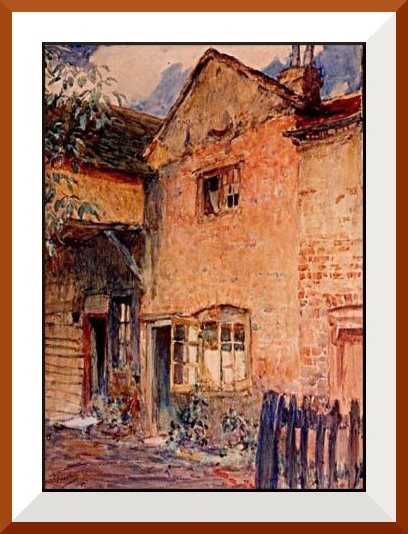George Owen Wynne Apperley was born to Margaret and William Wynne 17th June 1884 in Ventnor, Isle of Wight.
The aristocratic Apperley line traced principally back to the West Country and descended from the d’Apperleys of Normandy.
Not the first in the family to gain wide acclaim, Apperley counts, of note, among his forbears both Thomas Apperley (to be immortalised in the painting by Batoni), and George’s paternal Grandfather famous in the 19th Century for his sporting journalism – Charles James Apperley who wrote under the pseudonym of ‘Nimrod’ (shown here as painted in 1950 by G.O.W. Apperley from a print illustrated in the book “My Life and Times” by Nimrod).
Apperley’s early childhood was spent in Seaside towns on the South coast of England and in Alton, Hampshire. It was here when George was six that his father lost his life in a hunting accident leading his mother to take him to Torquay where they then settled.
Already at this time the young boy had shown considerable interest in drawing taking every opportunity to sketch the things around him. Apperley’s ambition in life was already decided – to become an Artist.
As an avid reader of books on painting, Greek mythology and Greek and Roman civilisation the young George was inspired by the subject matter and vowed to travel the world and experience such places first-hand.
His mother later re-married. It was not felt fitting that an Apperley should become simply a painter – indeed George’s stepfather was keen for him to maintain the family tradition and join the military while his mother harboured a desire for him to join the Church. Apperley’s interest in art however was obsessive and he was sent in consequence to school at Sandhurst and later to Uppingham – both renowned for their strict discipline. Here he showed little interest in academic subjects other than art and later persuaded his family that a tutor would be more beneficial to him.
It was around this time that Apperley sold his first painting, ‘ The Fleet in Torbay ‘, for the princely sum of 10 shillings.
George was keen to join Herkomer’s school of art in Bushey and when his family moved to St. Leonards he joined the art school there in preparation. In 1903 he enrolled at Herkomer’s but his rebellious streak and his somewhat Bohemian lifestyle led to his expulsion the following year – the tutors had, to that point, not been particularly impressed by his work.
Apperley’s dreams of travelling were realised in 1904 when, accompanied by his tutor, Major Wilkinson, he visited Italy. It was on this tour that his serious art education began, a period which would be instrumental in his future development.
On returning to Bushey, Apperley took his own studio. Many of the sketches and watercolour landscapes completed during his visit to Italy provoked an interest in his work from Herkomer who requisitioned him to assist in creating sketches for his own backgrounds. In fact the outfit worn by the Bullfighter in the painting ‘Toreador’ (shown at the Royal Academy) was almost completely Apperley’s work.
The artist was now beginning to sell several small works and was honoured when one of his watercolours,
‘A February Landscape’, was selected to be shown as part of an exhibition at the Royal Academy. Other local watercolours of the period include ‘Bell Yard Cottages, Bushey’ (shown here).

In 1905 Apperley travelled again with Wilkinson to Italy. The fruits of his work there served, on his return, to allow him to mount his first one man exhibition at the Baillie Gallery in London. Apperley sold some examples of the work he showed and the exhibition was a success achieving favourable reviews and establishing him a promising future. To add to this success he had a further picture shown at the Royal Academy in that year ‘Amphitheatre, Pompeii’.
The following years saw George continuing to travel, to exhibit and to broaden the subject matter which he chose to depict – by now a strong interest in pre-raphaelite themes had been established.
In 1907 he married Miss Hilda Pope, a union not deemed to be fitting by her parents, and the couple honeymooned in Lugano. On their return the newlyweds established their home at 25 Minster Road, West Hampstead, London for the first time affording Apperley a stable base from which to develop his painting techniques and to exhibit more frequently. Examples of one-man exhibitions around that time include those held at the Baillie Gallery London (1906), Leicester Galleries in 1908 and 1910 and Walker’s Art Gallery, London in 1912.
The Artist continued to travel and in order to supplement his income advertised for pupils to travel with him for sketching classes in the Italian lakes.
In 1913 the family (Apperley and Hilda now had two small children, Edward and Phyllis) moved to Bushey and it was here that the artist became more interested in portrait work, using as subject matter his family and moving from there into mythological compositions. These were not especially well received or understood by the critics at the time but Apperley himself responded to one particularly unkind review most eloquently: “Now my aim is to paint nature as I see her….I do not seek to create tricks and mannerisms so that any picture of mine shall at once be labelled an ‘Apperley’…I do not wish to be thought original. There are more than enough ‘original’ painters already. A beautiful effect of light or colour on a mountain , in a street or on a river produces feelings of emotion and pleasure in sensitive natures. When rendered on paper or canvas as truthfully as paint can render it, it will continue to produce these emotions and give that pleasure. This is my aim, it is more, it is my life.”
Perhaps it was the fact that life in England, in the ensuing years, with wartime approaching, restricted his power and inspiration to paint which led to exile from his homeland.
